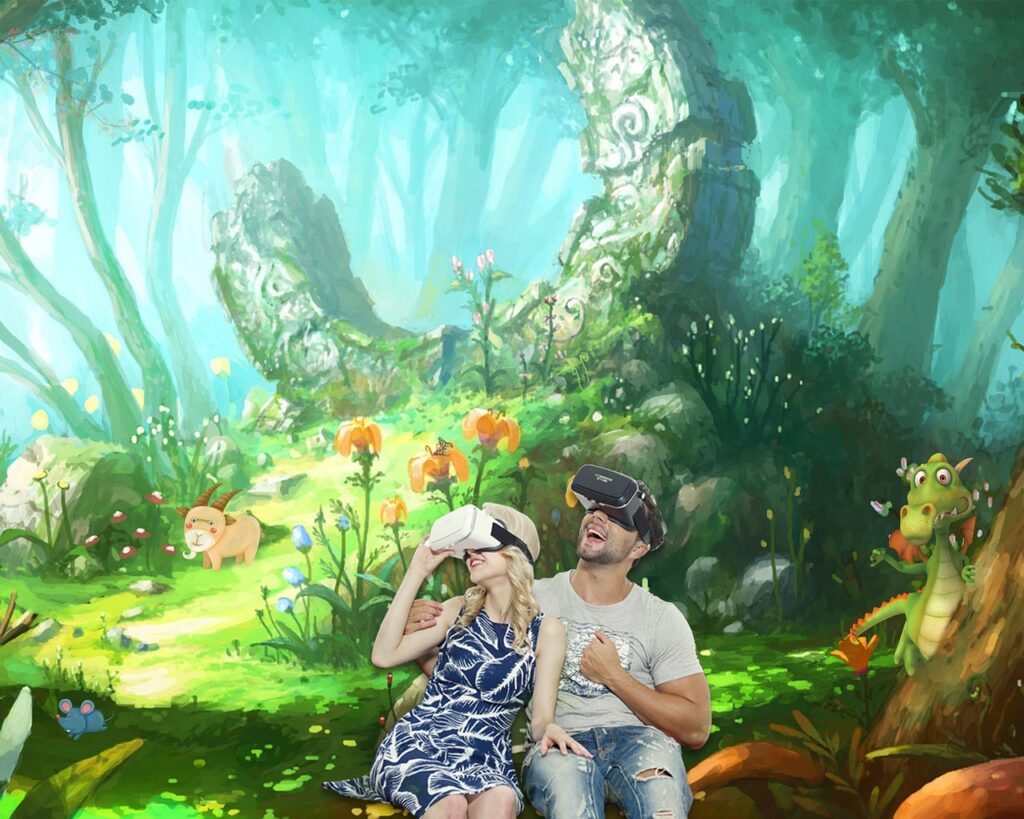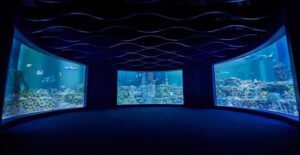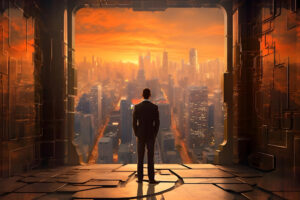Augmented Reality (AR) is no longer a fragment of science fiction. It’s here, weaving itself intricately into the fabric of our daily lives, revolutionizing sectors such as education, healthcare, and entertainment with innovative technologies that expand our horizons beyond traditional boundaries. In this immersive narrative, let’s delve into the transformative power of AR and unearth the latest gadgets and apps that are not just changing but enhancing our real-world experiences.
 Pin
Pin Image by: 鹏 赵 from Pixabay
Table of Contents
Education: Learning Reimagined Bringing History and Science to Life with Augmented Reality
 Pin
Pin Image from: Freepik.com
A world where history is not just a subject read from the textbooks, but a lived experience where students can walk side by side with the likes of Abraham Lincoln or discuss philosophy with Socrates in ancient Athens. This is the transformative potential that Augmented Reality (AR) brings to education. AR layers digital information onto the real world, and in the realm of learning, it converts classrooms into dynamic environments where education is not just absorbed but experienced.
In this enhanced learning landscape, students don’t just read about the human heart; they can see a 3D model of it beating above their desks. Biology classes become a journey inside the body, where students can take apart and explore each chamber of the heart, understanding the biology not as a static diagram but as a pulsing, living organ.
Microsoft’s HoloLens paves the way for such immersive educational experiences. By donning these AR headsets, students can dive into a world where complex physics equations demonstrate their principles in real space or where historical events unfold around them. The boundaries between past and present blur, and learners can witness the unfolding of significant historical events or delve into the wonders of the universe, visualizing and interacting with constellations and celestial bodies.
During times when resources are scarce—such as the disruptions brought by a global pandemic—these tools are invaluable. Physical laboratories that once buzzed with the activities of young scientists might be out of reach. Here, virtual labs come into play, allowing students to conduct experiments and explore scientific phenomena without the need for physical materials. The safety concerns and costs associated with traditional experiments are significantly mitigated, and learning continues uninterrupted, unconstrained by the physical limitations of the classroom.
The realm of chemistry, often a challenging subject due to its abstract nature, benefits greatly from AR applications like “Elements 4D”. Through such apps, students can combine digital representations of elements and watch as they react in real-time. The wonder of creating water by simply bringing together hydrogen and oxygen digitally, witnessing the explosion of colors and energy that signifies a chemical reaction. Such interactivity brings a new level of engagement and understanding; it’s like having the magic of the universe at one’s fingertips.
This educational revolution through AR takes the inherent curiosity that drives all learning and amplifies it, creating an environment where education is not just about memorizing facts but about exploration, adventure, and discovery. The dry pages of textbooks are transformed into living lessons that breathe excitement into the learning process. Retention rates soar as students learn by doing; concepts that were once hard to grasp become clear with the tangible representations AR offers.
This is the burgeoning reality of education—a use of technology that propels learners into front-row seats of history, into the very core of human anatomy, and into the microscopic world of atoms and molecules. AR in education isn’t merely an augmentation of reality; it’s an expansion of the horizons of human knowledge and an invitation to embark upon the most engaging adventure of all: learning.
Video: AR applications "Elements 4D"
Enhanced Healings: The Revolutionary Integration of Augmented Reality in Healthcare
In a world incessantly pushing the boundaries of what’s possible, Augmented Reality (AR) has emerged as a sterling testament to human ingenuity, especially within the intricate domain of healthcare. A quiet, sterile operating room where a surgeon, clad in scrubs, prepares for a complex procedure. She dons a pair of sleek, futuristic glasses, and the room transforms. The AR glasses become an extension of her expertise, a digital companion that superimposes a cascade of critical data over her direct line of sight.
Video: Using AR Glasses in Medical
This is not mere science fiction but the reality in cutting-edge operating theaters around the globe. These AR glasses reveal the invisible, such as the delicate roadmap of a patient’s veins, pulsing gently beneath the skin. The technology paints this intricate vascular network over the patient’s arm with impeccable accuracy, offering a gift of certainty in the high-stakes ballet of venipuncture.
It’s as though the practitioner possesses X-ray vision—”AccuVein” is such a system, and it’s changing the game for medical professionals and patients alike, with every successful needle placement.
The reverberations of this technological marvel extend far beyond the precision of injections and comfort of those wary of the needle’s prick. Consider the patient lying in their hospital bed, grappling with a new diagnosis that feels like a distant star—complex, mysterious, and utterly intangible. Along comes an application, akin to “Eye Decide”, cradling in its code the power to grant them a lens through which to view and comprehend their predicament.
A mere tablet in the hands of a skilled healthcare provider becomes a window to an unseen condition. Through AR, patients can witness the inner workings of their own body, not as a flat image on a screen or a page of text, but as a dynamic, three-dimensional entity. A heart beats, a retina captures light, all vividly animated in the space before them. It is a journey of understanding, one that cultivates an empowering sense of agency over their health predicaments.
In these personal odysseys of learning and healing, AR serves as the guiding light—a tool that, when melded with the touch of a caregiver, can demystify, soothe, and ultimately bridge the gap between patient and practice. It’s a poignant nexus of technology and humanity, enhancing the fusion of knowledge and care that forms the heart of the healing arts.
As we navigate through the ever-evolving story of healthcare, AR stands as a proud beacon of our collective pursuit to enhance and redefine the art of healing. It whispers a profound truth that extends beyond the walls of hospitals and into the core of human progress: that our greatest advancements may not be measured solely by the precision of our technologies, but by the depth of understanding and empowerment they bring to those who lie in wait for healing’s gentle hand.
Entertainment: A New Dimension of Fun
In the rapidly evolving realm of entertainment, a new spectacle is taking center stage, reshaping fun into a richer, more dynamic dimension. This is the world of Augmented Reality (AR), where the fabric of our reality interweaves with the fantastical, creating an enchanting tapestry of experiences that both astonish and delight.
Video: AR in Entertainment & Media
Picture a typical afternoon at a bustling city park. It’s transformed into a playground not just of slides and swings but of adventure seekers with their eyes glued to screens, swiping and tapping as they move. Here, in this melding of worlds, is where AR has cast its most public spell – through games like Pokémon GO. Its wizardry has simple phones summoning digital creatures amidst bushes and benches. Children and adults alike wander, eyes alight with excitement, as they track down a Pikachu by the fountain or a Charizard looming over the skyline. Physical exercise and digital exploration dance together, bound by AR’s enchanting steps.
But AR’s sleight of hand doesn’t end there. Move into the comfort of the modern living space, where the mundane action of furniture shopping is turned into an engaging game. With an app like IKEA Place, a coffee table is no longer just a picture in a catalogue; it’s a tangible presence you can almost touch and feel in your living room. Rotate it, change its color, or relocate it next to the sofa – all with a few swipes on your smartphone. The carousel of options is dizzying, and the act of choosing becomes a game of mix-and-match, played in the most personal of theaters – our homes.
Video: IKEA Place App
And then, there are the innovative headsets—the conduits of AR’s most potent magic. Take the Magic Leap 2, a device cloaked in anticipation. It is the wand waiting to be raised, promising a performance where high-fidelity graphics and responsive environments turn your local coffee shop or living room into a stage for the extraordinary. These headsets seek to dissolve the barriers between digital fantasy and tactile reality. Entertainment through these lenses is not merely viewed; it’s an experience that envelops you, fully. Movies could be watched with characters sitting beside you, concerts attended with the singer right in your space, virtually of course, but vividly like never before.
Video: Magic Leap 2
In this new dimension of fun, where AR leads the show, the audience does more than just watch—they participate, they move, they feel. It’s an unfolding narrative where each person is both the audience and the performer. Entertainment is no longer confined to screens or stages. It escapes, it expands, it engulfs, weaving in and out of our world, bringing joy, excitement, and a new perspective on the meaning of fun. This is AR in the entertainment industry, and it’s only just begun to tease the limits of our imaginations.
Odyssey of the Senses: The Sphere at The Venetian, A New Era of Las Vegas Spectacle
Stepping into a world where futuristic design and technological prowess converge to create an entertainment experience like never before. Nestled in the heart of Paradise, Nevada, just moments from the pulsating energy of the Las Vegas Strip, a monumental structure emerges, both a marvel of modern architecture and a sanctuary for the cutting edge of audiovisual splendor. This is the Sphere, also known as the Sphere at The Venetian Resort, a destination that promises to redefine the essence of music and entertainment.
Video: The Sphere at The Venetian Resort
Conceived by the creative minds at Populous, a global design firm renowned for breathing life into innovative spaces, the Sphere was born from an ambitious vision presented by the Madison Square Garden Company in 2018. It was then affectionately dubbed the MSG Sphere, a moniker that hinted at its destined grandeur.
As you approach the venue, its spherical silhouette dominates the skyline. Standing 366 feet high and spanning 516 feet wide, the Sphere is a testament to the audacity of human imagination, a badge of honor in the Nevada desert. Its 18,600-seat auditorium serves as a sanctuary where technology and artistry meld in an indelible embrace.
Enveloping attendees within its cavernous interior is a LED screen unlike any other, boasting 16K resolution—a canvas where each visual story comes to vibrant life. This wraparound spectacle immerses you in imagery so sharp, so enveloping, that the boundary between the physical and digital worlds blurs, leaving you suspended in a realm crafted from pure spectacle.
The auditory experience is no less revolutionary. Here, sound is sculpted by the most intricate audio technologies available—beamforming and wave field synthesis—into a multidimensional, directional symphony. Each note is a tactile entity, navigating the space, weaving through the crowd, and enveloping you in a cocoon of sonic fidelity. Meanwhile, strategic 4D physical effects punctuate the experience, commanding the very air to act, to move with purpose, turning the intangible into an experience that brushes against skin, courting every sense.
Yet the Sphere’s ambitions extend beyond its internal marvels. The exterior is itself a canvas, swathed in over half a million square feet of LED displays that ignite the night sky with the luminescent allure of a techno-organism alive with potential.
This arena is not just a structure; it is a living, breathing entity of light and sound. With a price tag of $2.3 billion, the Sphere stands as the most expensive and most extravagant entertainment sanctuary ever to be constructed in Las Vegas. It is not merely a venue, but a beacon, a herald of a new age of experiential bliss—a temple where every performance is transformed into an odyssey.
As the Sphere nears its completion and prepares to fling open its doors to the world, it waits, breath held, ready to inscribe new memories onto the fabric of time, and to leave an indelible mark on the hearts and minds of its guests. In the realm where history weds technology, the Sphere will soon stand as a shining monument to the power of human creativity and technological mastery, a symbol of progress in the oasis of the desert, a spectacle poised to enchant the masses for generations to come.
Through Time's Lens: Augmented Reality Transforms Tourism
Stepping onto the cobblestone streets of an ancient city, a pair of glasses perched upon your nose. This is not just any pair of spectacles, but a window to the past, a portal powered by the magic of Augmented Reality (AR) that bridges centuries in the blink of an eye.
Video: AR in Travel & Tourism
AR in tourism is a burgeoning affair where history, culture, and the digital revolution meet to craft experiences that are as informative as they are enchanting. As you walk through the historical center, your AR device — it could be a pair of smart glasses, a headset, or simply your smartphone — begins to overlay images of eras gone by onto the modern-day landscape around you. Ruins are rebuilt before your eyes, ancient denizens stroll beside you, and narrations of forgotten tales whisper in your ears, all the while anchored to the very spots where history unfurled.
This seamless melding of past and present doesn’t end there. Menus of traditional eateries float in the air, annotated with trivia about the origins of dishes and the anecdotes of the locales. You select a dish by simply gazing at it a moment longer, feeling like a time traveler placing an order across dimensions.
Elsewhere, AR turns a simple nature hike into an educational odyssey. Information about wildlife, plants, and the geological wonders you encounter pops up in your field of vision, interactive and engaging. A once barren viewpoint now serves as a storytelling precipice, revealing the area’s transformation through the ages with a 360-degree panorama that shifts as you turn, each angle a different epoch.
Tourist attractions, often overwhelmed by crowds, recapture their bygone aura through this tech. In Rome, the Colosseum teems with virtual gladiators and roaring crowds, reenacting historical spectacles. In Egypt, the pyramids and Sphinx regain their lustrous facades, pharaohs’ processions majestically outline against the setting sun. The info provided by AR is deeper than any placard or guidebook, full of interactive content like maps, timelines, and puzzles that unravel the significance of the place.
Museums, no longer constrained within walls, spill their collections into the streets. AR transforms statues and landmarks into storytellers, engaging tourists in scavenger hunts that reveal histories and secrets as they solve clues.
AR has practical applications, too. Signs in foreign scripts are translated in real-time, overlaying your language of preference over the original text, making navigation smooth and locals’ lives less disrupted by the puzzled faces of tourists.
This is tourism reimagined, a harmonious blend of education and entertainment, narrative and exploration, all facilitated by the unobtrusive technology that AR exemplifies. It personalizes journeys, caters to different interests and learning styles, and, above all, makes the invisible visible — the forgotten remembered and the static dynamic.
As we embrace AR in tourism, we are not just visitors but active participants in the storytelling of the world’s most wondrous places, crafting a personal narrative as rich as the destinations themselves. The promise of AR in tourism lies not just in the enchantment it creates but in the understanding and connection to our world’s vast tapestry of histories it fosters.
Augmented Reality (AR) is reinventing tourism by breathing digital life into physical locations
AR in tourism is a burgeoning affair where history, culture, and the digital revolution meet to craft experiences that are as informative as they are enchanting. As you walk through the historical center, your AR device — it could be a pair of smart glasses, a headset, or simply your smartphone — begins to overlay images of eras gone by onto the modern-day landscape around you. Ruins are rebuilt before your eyes, ancient denizens stroll beside you, and narrations of forgotten tales whisper in your ears, all the while anchored to the very spots where history unfurled.
1. Interactive Historical Sites: Visiting the Colosseum in Rome and through AR glasses, gladiators and ancient crowds are brought to life, reenacting historical events around you. This immersive experience entices travelers with a powerful narrative that traditional guidebooks can’t match.
2. Museum Enhancement: In the Louvre, AR can overlay artist details and painting techniques directly onto the artwork you’re viewing. No more audio guides—now the stories unfold as visual layers on the canvas itself, deepening the visitor’s engagement and understanding.
3. Urban Explorations: Apps like ‘AR City’ use smartphone cameras to overlay directional arrows and points of interest onto the real-world streetscape. Tourists navigate with ease, learning about landmarks as they go, turning a simple walk into an informative tour.
4. Cultural Festivals: AR transforms festivals by adding digital elements to real-world venues. The Brazilian Carnival could feature interactive maps with folklore tales popping up as you traverse parade routes, making the experience more vibrant and educational.
5. Wildlife Tourism: When safari-goers point their devices at animals, they receive instant information on species and habitat. In zoos, AR markers next to enclosures reveal the animals in their natural environments and simulate behaviors tourists wouldn’t normally observe.
By implementing AR, tourism evolves into a dynamic, informative, and memorable journey, enhancing the traveler’s experience beyond the confines of traditional sightseeing.
FAQs: Discovering the Future with Augmented Reality (AR)
AR is a technology that superimposes computer-generated images on a user’s view of the real world, providing a composite view. This can greatly enhance the way we see, interact, and learn from our environment.
AR in education allows for interactive learning experiences, where difficult concepts are visualized. Students can interact with 3D models, historical figures, or molecular structures, improving engagement and understanding.
Yes, AR has significant potential in healthcare, such as enhancing the precision during surgery by projecting vital information directly into the surgeon’s field of vision, or aiding patient education through 3D visualizations of conditions and treatments.
Entertainment venues like The Sphere in Las Vegas use AR to create immersive experiences, utilizing advanced sound systems and visual projections that transform the audience’s experience into something beyond a traditional concert or show.
AR is becoming increasingly accessible through mobile apps and devices like Microsoft’s HoloLens. With advancements in technology, AR experiences are becoming more common in educational tools, mobile applications, and at entertainment events.
Benefits include enhanced engagement, better retention of information, the ability to visualize complex subjects, and making learning more enjoyable and interactive.
In tourism, AR can overlay historical information and reconstruct historical sites in real time, giving tourists a deeper understanding of the location they’re visiting and a unique way to experience the history.
AR is unlikely to completely replace traditional methods but rather complement and enhance them. It provides alternative ways to engage with content that can improve understanding and retention.
The cost can vary. Some AR applications for smartphones and tablets are quite affordable. However, more sophisticated implementations, like those used in healthcare or large entertainment venues, can be costly though prices are likely to decrease as the technology becomes more widespread.
AR is poised to make education more engaging, healthcare more precise, and entertainment more immersive. Ultimately, AR could redefine how we learn, treat illnesses, and experience the world around us.




























